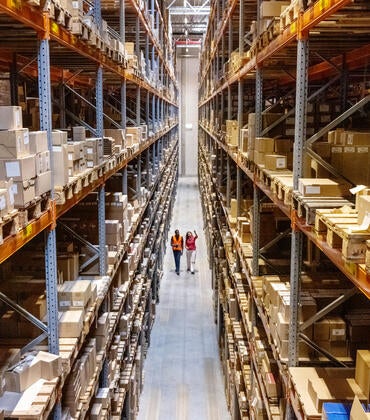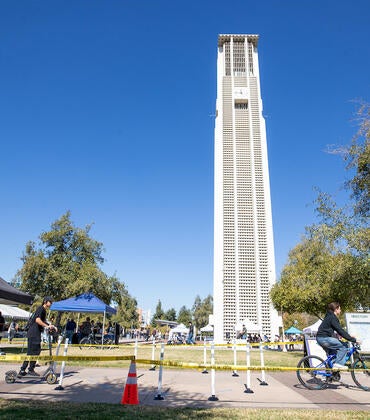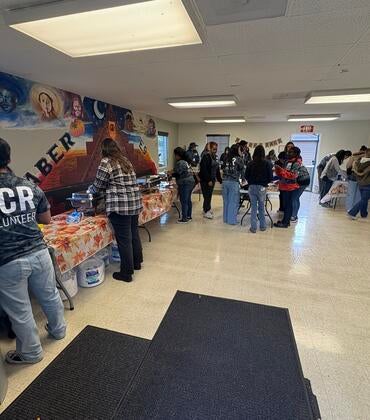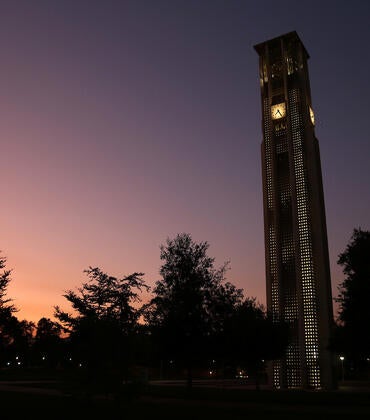Daryle Williams has been a visible presence at UC Riverside since becoming dean of the College of Humanities and Social Sciences on Sept. 1. Whether welcoming students on their first day of class, getting to know faculty members, or even joining athletes for push-ups, Williams has taken to his new position with an enthusiastic energy.
A prominent historian who spent 25 years with the University System of Maryland, Williams co-created the online database Enslaved.org, which collects data about the lives and experiences of enslaved people.
Born in San Francisco and raised in San Diego County, Williams has long been an admirer of the UC system.
In a recent interview, Williams talked about his first few months at CHASS, his plans for the future, and how UCR will join the Enslaved.org project.
He also described why it was important for him to introduce himself to students during the first week of classes in what he described as informal walkabouts around the campus.
Below is an edited transcript of the conversation.
What was important to you about having that in-person interaction? What have you taken away from the experience?
It is and remains extremely important to me. We have two classes of students who have not had the opportunity to come to class until (recently) because campus was closed during the pandemic. To be there with them at that moment, this exceptional moment, to figure out where do they go on campus, where are their classes, what do you wear, who do you talk to, who are your allies and assets, I think that’s exceptionally important.
I’m also experiencing that myself. This is new for me. “Where do I go, how do I get there, who are my allies, what do I wear, what do I say,” is also something I sympathize with even with the role I have as the dean. I found it gratifying. I felt I connected in those brief interactions. I connected with people who needed connection, wanted connection, because of where they are in their lives at UCR.
What appealed to you about UCR?
The UC system was always in my mindset as the best public research system in the United States and in the world. That would have been a very natural path for someone like myself who graduated high school in San Diego. The attraction of UC based on its quality and contributions to the state of California was a comfortable and familiar place.
The thing that really attracted me about this position here is the particular way you take the assets of a public university R-1 institution for the demographics and the students that are here, these first-generation, these largely working-class or student workers who have this tremendous educational institution to bring them through their studies to be in the world. I think, wow, how important it is when you think about public resources and assets and they’re there for this group, these demographics.
You mentioned first-generation and Pell Grant students. UC Riverside has a high percentage of students who come from those backgrounds. I understand that’s important to you.
It is exceptionally important to me. I can’t say I was exactly a first-generation student because there were higher education degrees in my family. However, I was a Pell Grant student. I went to Princeton. I was a work studies student. I did food service for the majority of my time in college so in a sense I worked my way through college but in a very privileged environment.
Nevertheless, I understand what it’s like to be someone who is economically not necessarily positioned to succeed in a higher education institution but through support, through work study and Pell Grants, to have access to education. I’ve experienced that myself. I’m sympathetic to it. I want to be there for those who are similarly positioned in their socioeconomic lives and also should be positioned to have the ability to study and learn to do something important in the world and in their lives.
CHASS is the largest college at UC Riverside, with 20 departments serving more than 10,000 students in more than 60 majors. How would you describe the shared mission of what CHASS does?
The majority of the disciplines that we have center humans, center the human experience, whether it’s the individual or the social. Whether we see this in political science, or in sociology, or some of the social sciences, it’s this ability to center humans that each of our disciplines have which I think is really wonderful. It’s the ability also to have tools to understand the best, most creative, most expansive, most inspirational things that humans can do to themselves and to others.
We also have these tools to understand the most horrible things that humans are capable of doing to themselves, to others, to the environment. These disciplines center humans and the human experience but in the huge scope of what the human experience is, whether it’s questions about formation of justice or about racism as experienced and constructed at individual creative levels or the social structural level. That is what CHASS is about, what CHASS can do, and it’s really appealing as a sprawling interdisciplinary academic organization.
What are some of the initiatives you want to introduce at CHASS?
In my particular research, I work on Brazilian slave society and use of digital humanities tools to explore that. I’m really eager to bring UCR into the family, as it were, of Enslaved.org, and some of the work we do on slavery studies, digital humanities, and also use this as a springboard for others interested in studying broad-based questions related to slavery and emancipation or black experiences globally or digital humanities and digital tools. Public scholarship is a big interest of mine and I’m interested in supporting that.
When I stepped in, there were conversations about moving forward to establish a couple new programs: a department of Black Studies, a department of Environmental Sustainability and Health Equity. These are going through the review and approval process.
Certainly, supporting initiatives to create departments but supporting the study of Blacks and Blackness, anti-racism as a mode of organizing a curriculum or research (is important). What about when we think about those people who study environmental sustainability and they bring those conversations about health, well-being, and health disparities across a range of disciplinary perspectives. And speaking to this moment when we’re thinking about the pandemic and we’re thinking about all the different ways in which the environment and health disparities are so deeply entwined, here in the Inland Empire and elsewhere.
These are parts I find really exciting to be on the cutting edge of conversations in CHASS and how they might develop into new curriculum and new departments. But that doesn’t leave behind the things that are taking place in the established programs that have been here since the university came together in the 1950s and 1960s. I need to get out there and find out what good things are happening in the day to day
How do you hope to further develop the Enslaved.org site at UCR and what perspective does this region provide on that topic?
To bring UCR into the Enslaved.org ecosystem, we’ll have some of the research activity take place here with student, faculty members and post-docs. A summer opportunity research program that I piloted at the University of Maryland last summer, we’ll bring that to UCR and to UCR students, so it’s a new opportunity for undergrads to get research experience and do slavery studies and digital humanities work.
Most of this work has been in the Midwest and East Coast. So what is it like when you think about slavery studies in a landscape which supposedly had nothing to do with enslavement? As a matter of fact, we know that’s not true. There’s plenty of research that says enslavement as it was legible in the U.S. South, for instance, had many ramifications in the West and in California.
We have an opportunity to take some methods we’ve developed at Enslaved.org and see how they resonate in different historical contexts and source material such as Indigenous life in the California Mission system.
What were your goals when you began this database? It seems like people understand slavery on an abstract basis, but your project is about putting names and faces to it.
We have this false but nevertheless long history of thinking about slavery and enslaved people as anonymized, commercialized, objectified units of labor that had no history, no identity, no family and they were brutalized to the point of not having an internal life or complexities we would associate with having free well. That’s false. It’s not true at all. Part of it is to address the erasure of the complexity of the individual lives of enslaved people at various places and times. But it’s also to recognize the violence of slavery, enslavement, chattel slavery. Those are real. They really did strip individuals, at least in the historical record, of the name, whether that name was originally an African name that was transformed or imposed as a Western Christian name or no name at all.
There are so many different kinds of records that exist that have named individuals, enslaved individuals, and non-enslaved individuals as well. So to center that archival material and to use some digital tools, out of that, even with the fractured way the slavery and historical record is, we have some ability to piece together fragmentary evidence. It opens up an idea about an internal life, agency, voice.
Through UCR ARTS, CHASS is very involved in Riverside through arts and music programs. What do you hope to see happen with that type of community involvement?
My husband and I made a decision when I took the job we were going to live in Riverside, we’re going to be members of this community. UCR ARTS, I consider it to be local, six blocks from my house. I have a direct feeling and investment in this community and how the institutions of the college are invested in the cultural and community life of the City of Riverside and Inland Empire more broadly.
It’s fantastic that UCR is part of that, and we have an institution that does these things that are not part of the university. We have the university and cultural assets that are together in the Culver Center and California Museum of Photography. It’s become our springboard with our conversations with the Cheech Marin Center and the city. What does that look like when we’re part of a network of exhibition and cultural spaces? How then do we think about our students who might be interested in careers in cultural institutions and how they can think of multiple opportunities in Riverside, or teaching opportunities in spaces that are not just physically here on campus but also downtown.
That’s one piece. There’s a lot of work also in the college which is really interested in health equity and disparities in the region, the warehousing and logistics industry, and how this creates at one level this economic development opportunity but also creates tremendous difficulties for air and health quality and environmental justice issues. So we’ve got scholarship that is interested in questions about community and we have communities that live in the impact of the scholarship. We also have scholarship students and staff who can be engaged in trying to address concerns about education quality, health disparity or environmental health issues in the Inland Empire.
This R-1 institution exists in this place and we’re of this place as well. So I think it’s a really important thing. It’s going back to that idea that CHASS centers people and this is a place of people.



